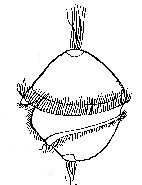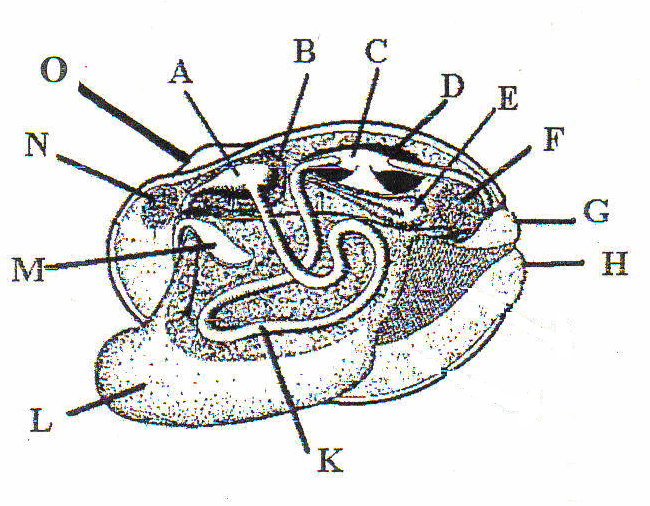
2.
The free swimming ciliated larva
MOLLUSK REVIEW (we did this in class)
1.
Type of body cavity found in MOLLUSKS
 |
2.
The free swimming ciliated larva |
3.
Type of circulatory system found in bivalves and gastropods.
4.
The flexible tongue-like strip covered with abrasive teeth that is found in all
mollusks except bivalves is called
5.
Which organ is used by clams for respiration?
6.
The octopus, squid, and chambered nautilus belong
________________.
 |
7.
The bump on the dorsal edge of a
|
9. Bivalves
are SESSILE as adults.
What does
this mean?
10.
Slugs and snails
belong to the CLASS of Mollusks called _______________.
Bivalves
Gastropods
Cephalopods
11.
Name the two functions of the gills in a clam.
12. Only
group of mollusks that does NOT have an open circulatory system or a trochophore
larva.
Bivalves
Gastropods
Cephalopods
13.
The circulatory fluid in a clam is called ___________________
14.
Gastropods undergo a process called ___________in which their visceral
mass twists 180 o
so
the gills,
anus, and mantle cavity end up at the front end of
the animal.
| 15. The function of M is to ____________________________ |
 |
16.
The
area above the foot that contains the
17.
Which kind of mollusks are
FILTER FEEDERS?
Bivalves
Gastropods
Cephalopods
 |
18. G = ______________ |
|
19.
The
function of E is to ________________________________
|
 |
20.
The
layer that secretes the shell in a clam is the
____________________
21. The structure that wraps around the intestine and pumps hemolymph is the_______________.
22.
TRUE
or
FALSE
Clams have a nervous system like an earthworm.
23. Name the 4 body systems in a clam that use the mantle cavity.
24. Mollusks
are _________________.
INVERTEBRATE PROTOSTOMES
INVERTEBRATE DEUTEROSTOMES
VERTEBRATE
DEUTEROSTOMES
VERTEBRATE PROTOSTOMES*
 |
25.
|
26.
What color is bile?
27. Give a function for the digestive gland.
28.
TRUE or FALSE
Nitrogen waste exits through the anus in a clam
29. Tell one way clams are different from earthworms.
30. Tell one way clams and earthworms are alike.
ANSWERS
1. Eucoelom
2. Trochophore
3. OPEN
4. Radula
5. Gills
6. Cephalopods
7. UMBO
8. Chromatophores
9. Stay in one place
10. Gastropods
11. Trap food & exchange gases
12. Cephalopods
13. Hemolymph
14. torsion
15. move food up from gills to mouth
16. visceral mass
17. Bivalves are filter feeders
18. excurrent siphon
19. remove nitrogen waste
20. mantle
21. heart
22. False:
earthworms have 2 cerebral ganglia and 1 ventral nerve cord
Clams have 3 pairs of ganglia; and 4 nerve cords
throughout their bodies
23. Digestive (digestive waste is
released from anus here)
Excretory (nitrogen waste is released by
kidney here)
Reproductive (sperm or eggs released here;
internal fertilization happens here)
Respiratory
(gills are located here)
24. Invertebrate protostomes (* By the way: There is no such thing as vertebrate
protostomes)
25. H
26. green
27. make bile, finish digestion, absorb nutrients
28. FALSE: Keep your waste straight!
Nitrogen waste is collected by kidney and is released into
mantle cavity.
DIGESTIVE WASTE (FECES) exits through the ANUS!
29.
| CLAMS | EARTHWORMS |
| Open circulation | Closed circulation |
| Separate sexes | Hermaphrodites |
| no cephalization | cephalization |
| 3 pairs ganglia/ 2 pairs nerve cords |
1 pair cerebral ganglia/ 1 nerve cord |
| kidneys | nephridia |
| gills | breathe through skin |
| have either internal (fresh) OR external (marine) fertilization depending on environment | external fertilization only |
| indirect developement (trochophore) | direct development |
30.
Both CLAMS and EARTHWORMS are/have:
Eucoelom
Invertebrate protostomes
Dorsal heart/ventral nerve cord
2 opening digestive system
use
sexual reproduction
bilateral symmetry
hydrostatic skeleton